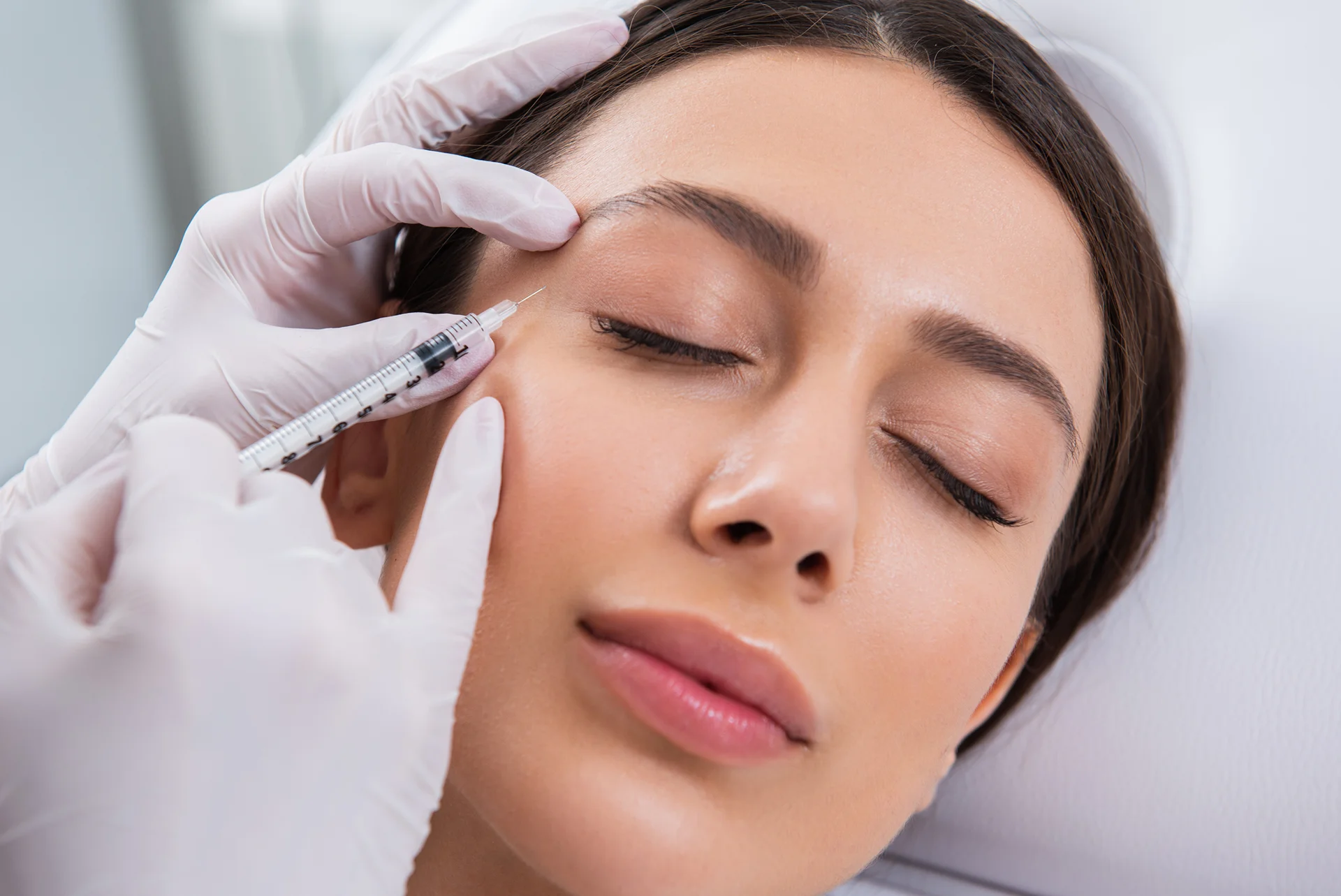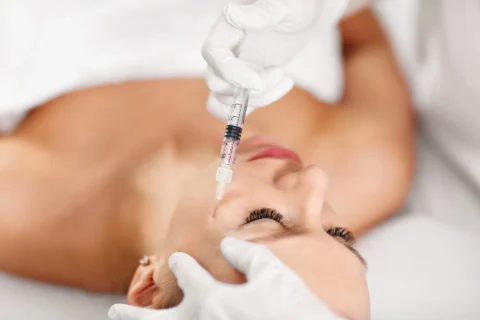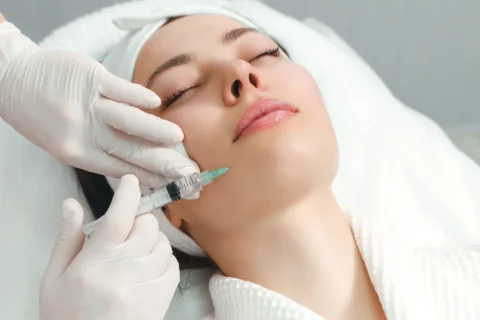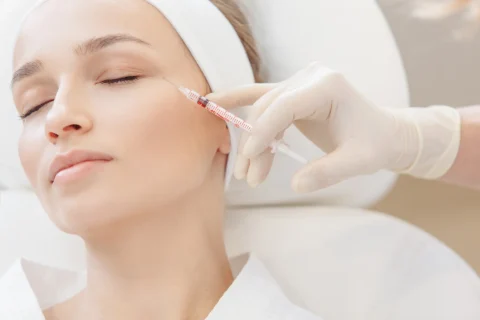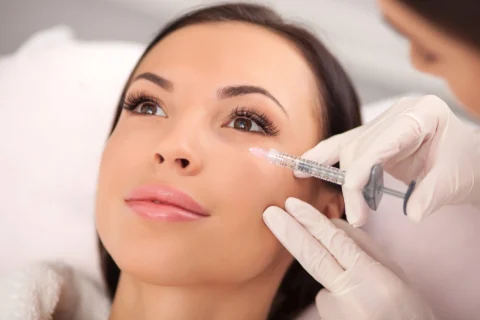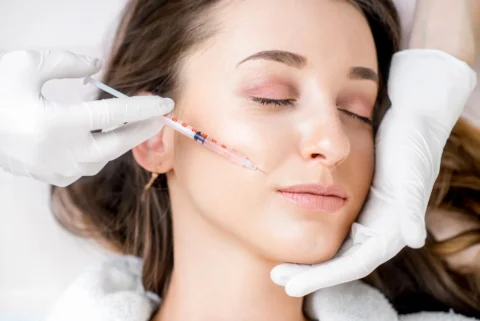A Comprehensive Guide to Using Dermal Fillers for Crow’s Feet
Crow’s feet, the fine lines from the corners of your eyes, are a natural part of aging. But they can be a source of self-consciousness. Dermal fillers smooth out these lines and restore a youthful appearance.
In this guide, we’ll explore what causes crow’s feet, who might benefit from dermal fillers, and what to expect from the treatment.
What Causes Crow’s Feet?
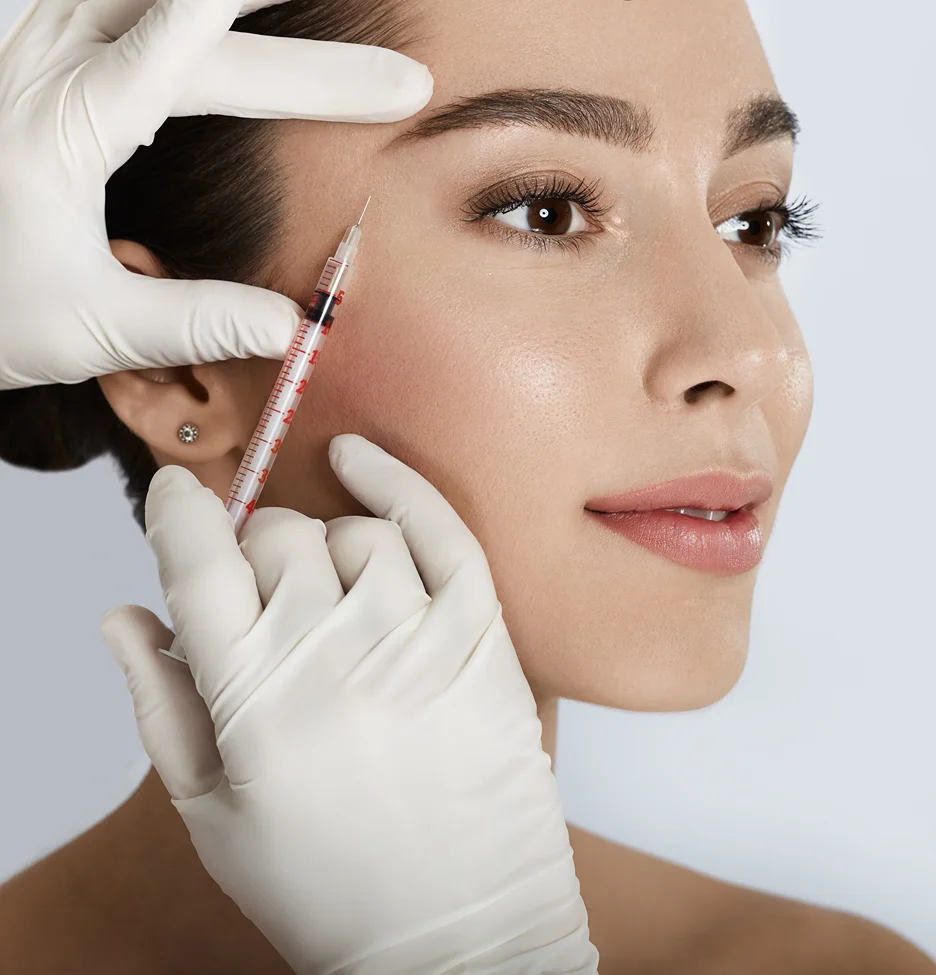
Crow’s feet, the fine lines and wrinkles that radiate from the corners of the eyes, are a common sign of aging and are influenced by various factors. Here’s a comprehensive look at the causes of crow’s feet:
Loss of Skin Elasticity and Collagen
The skin’s natural aging process leads to a decrease in collagen and elastin, which are essential proteins that maintain skin firmness and elasticity. As we age, the skin around the eyes, which is already thin, becomes even thinner and more prone to wrinkles.
Facial Movements and Muscle Contractions
Facial expressions, such as smiling, squinting, and frowning, cause the muscles around the eyes to contract. Over time, these repetitive motions can lead to the formation of crow’s feet . The orbicularis oculi muscle, which encircles the eye socket, is particularly involved in these expressions.
Environmental Factors
Exposure to UV light from the sun or tanning beds can accelerate the breakdown of collagen, leading to premature skin aging and the development of crow’s feet . Protective measures like wearing sunscreen with an SPF of 30 or higher can help mitigate this damage.
Lifestyle Habits
Smoking and exposure to free radicals can exacerbate the appearance of crow’s feet by damaging the skin and reducing collagen production. A healthy lifestyle, including a balanced diet, adequate hydration, and regular exercise, can support skin health and potentially reduce the severity of crow’s feet.
Other Contributing Factors
Genetics can play a role in the development of crow’s feet, as some individuals may be predisposed to earlier or more pronounced wrinkles . Hormonal changes and the natural sagging of the forehead and cheeks with age can also affect the appearance of the eye area
Can Fillers Help Crow’s Feet?
Dermal fillers are FDA-approved for anti-aging treatments and highly effective against crow’s feet. They add volume under the skin, smoothing out wrinkles.
Hyaluronic acid fillers are the best treatment for age-related crow’s feet. Dysport, a type of filler, is particularly effective and approved in numerous countries.
Ideal Candidates
Are dermal fillers for everyone? Ideal candidates have good skin health, realistic expectations, and want to address fine lines and static wrinkles.
When Fillers May Not Be Ideal
Dermal fillers may not be enough for very deep-set wrinkles. Certain medical conditions may affect their suitability. It’s crucial to discuss your medical history with a healthcare provider.
Combination Treatments
Dermal fillers for crow’s feet are often used with Botox for best results. This combination targets both dynamic and static wrinkles, providing a comprehensive approach to rejuvenating the eye area.
How Long Do Fillers for Crow’s Feet Last?
Fillers’ effects on crow’s feet can vary, lasting from three months to a year or more, depending on the specific product. Juvederm, a commonly used filler, can last up to 18 months, depending on the formulation.
Longevity of Fillers
Fillers’ longevity varies based on type and treatment area. Hyaluronic acid-based fillers last 6 months to 2 years or longer. JUVÉDERM VOLUMA® can last up to 24 months, RADIESSE about 12 months, Sculptra® Aesthetic more than 2 years, and Bellafill® more than 5 years. Fillers stimulate collagen production, leading to longer-lasting improvements.
What to Expect from the Dermal Filler Treatment for Crow’s Feet
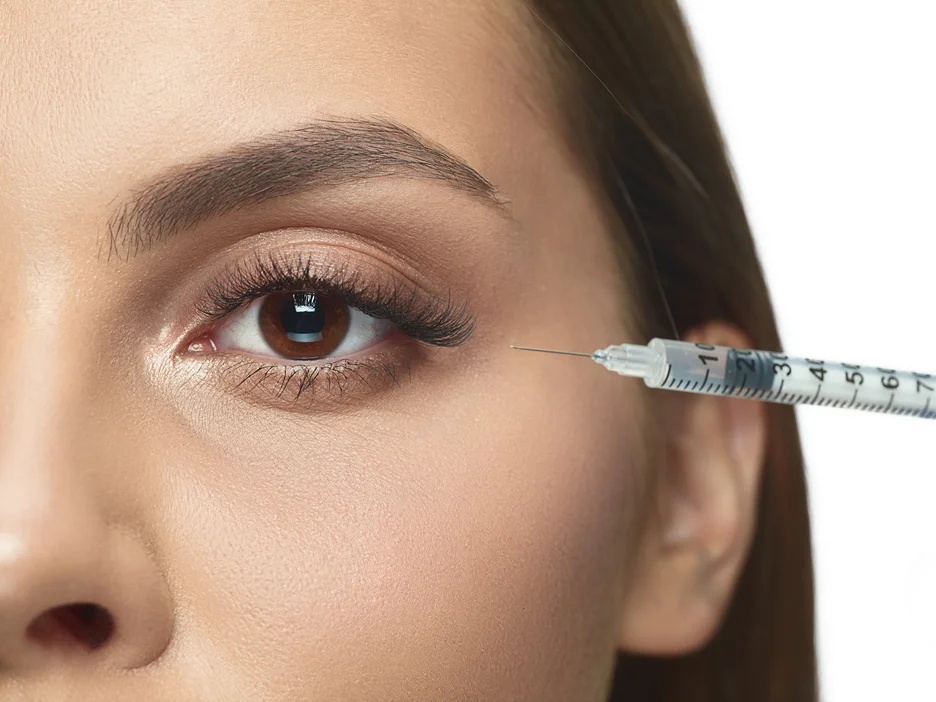
Choosing the Right Filler
Not all fillers are equal when treating delicate areas like crow’s feet. Soft, hydrating fillers, based on hyaluronic acid, are recommended due to their smooth consistency and natural-looking results. Denser fillers may not be suitable for the thin skin around the eyes.
The Importance of a Skilled Injector
The skin around your eyes is thin, so precision is crucial. An experienced injector will provide the best aesthetic outcome and minimize complications. They understand facial anatomy and can tailor the treatment to your needs.
The Procedure
Your comfort is a priority. The area will be cleansed, and a numbing agent may be applied. The injections are quick and involve placing filler to smooth wrinkles and support the skin. Some discomfort is possible, but it’s generally well tolerated.
Results and Aftercare
You may notice some immediate improvement, but the full effect of the fillers can take up to a couple of weeks. Aftercare includes managing bruising or swelling and following specific instructions given by your provider.
Risks and Potential Side Effects of Crow’s Feet Fillers
Common Side Effects
Like any procedure, there are potential side effects to be aware of, including bruising, swelling, and temporary redness at the injection sites. Occasionally, lumps or bumps may develop, which can be massaged out or will resolve on their own.
More Serious (But Rare) Complications
Rare but severe complications like vascular occlusion can occur, so choosing a skilled injector is crucial. Allergic reactions to the filler material, though uncommon, are also possible. Unnatural results from improper placement are another risk, emphasizing the need for an experienced professional.
How Long Do Crow’s Feet Filler Results Last?
Factors Affecting Longevity
The effects of fillers depend on the product, metabolism, and aftercare. Results in the crow’s feet area can last from months to a year. Skin type, lifestyle, and aging affect the duration, despite some fillers offering more longevity.
Realistic Expectations
Fillers provide a refreshed appearance, but the results are not permanent. Regular maintenance sessions are necessary to sustain the effect.
Maximizing Treatment Results and Maintaining a Youthful Look
Importance of Skincare
Taking good care of your skin can extend the life of your filler results. This means using sunscreen to protect against UV damage, retinoids to promote skin renewal, and maintaining a healthy skincare routine.
Consider Combination Treatments
Consider discussing additional treatments with your provider for optimal outcomes. Complementing fillers with options like Botox or laser therapies can address more skin concerns and contribute to a comprehensive anti-aging strategy.
Lifestyle Matters
A balanced diet, regular exercise, and staying hydrated are key for healthy skin. Avoiding smoking and excessive alcohol can help maintain filler results and skin quality.
Final Thoughts: Choosing the Right Provider and Making an Informed Decision
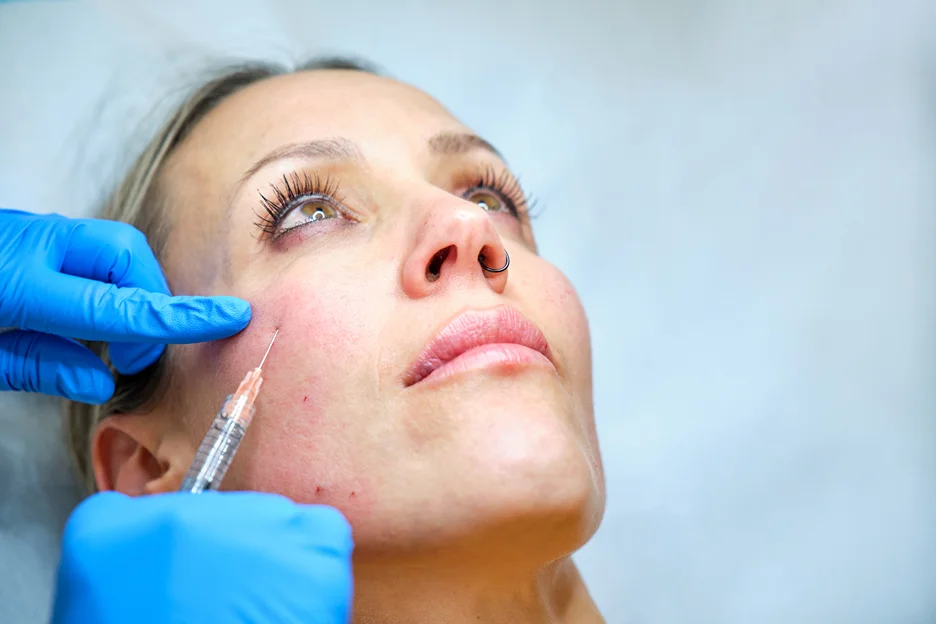
Don’t Skimp on Expertise
Choose an injector with expertise in facial anatomy and a successful treatment portfolio. The right provider ensures safety and delivers the best aesthetic results.
Questions to Ask
Before treatment, ask about the injector’s qualifications, experience, and request before-and-after photos. Inquire about the fillers used, potential side effects, and what to expect during and after the procedure.
It’s Your Choice
Deciding on dermal filler treatment for crow’s feet is a personal choice. Consider the benefits, risks, and costs. Be comfortable with your provider and understand the procedure. With the right approach, you can achieve a refreshed, natural look.
Remember, knowledge is power when it comes to cosmetic treatments. With this guide, you’re better equipped to decide if dermal fillers for crow’s feet are right for you.
FAQ Dermal Fillers for Crow’s Feet
Botox or Juvederm: Which is Better for Crow’s Feet?
Botox and Juvederm treat crow’s feet differently. Botox paralyzes muscles to reduce wrinkles caused by facial expressions and lasts 3-4 months, while Juvederm adds skin volume and is better for deeper wrinkles.
A study suggested that Dysport may be more effective than Botox for crow’s feet, but the choice between Botox and Juvederm depends on individual needs and wrinkle type.
What is Better than Botox for Crow’s Feet?
Botox is popular for treating crow’s feet, but other treatments can be effective for deeper wrinkles. Juvederm dermal fillers provide longer-lasting results, up to a year or more.
Ablative laser resurfacing like Forever Young BBL offers results lasting up to ten years, but requires weeks of recovery. Non-invasive options include retinoids and Vitamin C serums to promote collagen production and reduce crow’s feet. Microneedling also induces collagen production and treats crow’s feet.
Do Fillers Sag Over Time?
Dermal fillers do not inherently lead to sagging skin over time. In fact, they add volume and can eliminate sagging skin by occupying the space once filled with natural fat.
However, excessive or improper use can stretch the skin, potentially causing pockets. It’s important to note that injecting facial fillers does not stretch the skin under normal circumstances.
Does Your Face Go Back to Normal After Fillers?
After non-permanent fillers wear off, the skin is expected to recover and return to its original shape. In many cases, the skin may even look better due to stimulated collagen production.
However, overuse or improper placement of fillers can affect the face mechanics, and in rare cases, the face may not return to its original state. For most patients, the skin will return to its previous condition if they stop using dermal fillers.
Do Fillers Look Better Over Time?
Fillers may look more natural as time passes, especially after any initial swelling or bruising has subsided. The best results are typically seen 1 to 2 weeks post-treatment, with improvements continuing for up to three months.
However, it’s a misconception that fillers are expected to look better over time; they are designed to maintain the appearance rather than improve it.

